1. Te Morenga L, Mallard S, Mann J. Dietary sugars and body weight: systematic review and meta-analyses of randomised controlled trials and cohort studies. BMJ. 2012; 346:e7492. PMID:
23321486.
2. Te Morenga LA, Howatson AJ, Jones RM, Mann J. Dietary sugars and cardiometabolic risk: systematic review and meta-analyses of randomized controlled trials of the effects on blood pressure and lipids. Am J Clin Nutr. 2014; 100:65–79. PMID:
24808490.
3. Malik VS, Pan A, Willett WC, Hu FB. Sugar-sweetened beverages and weight gain in children and adults: a systematic review and meta-analysis. Am J Clin Nutr. 2013; 98:1084–1102. PMID:
23966427.
4. Malik VS, Popkin BM, Bray GA, Després JP, Willett WC, Hu FB. Sugar-sweetened beverages and risk of metabolic syndrome and type 2 diabetes: a meta-analysis. Diabetes Care. 2010; 33:2477–2483. PMID:
20693348.
5. Ministry of Health and Welfare, Korea Disease Control and Prevention Agency. Korea Health Statistics 2019: Korea National Health and Nutrition Examination Survey (KNHANES VIII-1). Cheongju: Korea Disease Control and Prevention Agency;2020.
6. Lim H, Lee HJ, Choue R, Wang Y. Trends in fast-food and sugar-sweetened beverage consumption and their association with social environmental status in south Korea. J Acad Nutr Diet. 2018; 118:1228–1236.e1. PMID:
28988839.
7. Chung S, Ha K, Lee HS, Kim CI, Joung H, Paik HY, Song Y. Soft drink consumption is positively associated with metabolic syndrome risk factors only in Korean women: data from the 2007-2011 Korea National Health and Nutrition Examination Survey. Metabolism. 2015; 64:1477–1484. PMID:
26299893.
8. Kang Y, Kim J. Soft drink consumption is associated with increased incidence of the metabolic syndrome only in women. Br J Nutr. 2017; 117:315–324. PMID:
28166856.
9. Shin S, Kim SA, Ha J, Lim K. Sugar-sweetened beverage consumption in relation to obesity and metabolic syndrome among Korean adults: a cross-sectional study from the 2012–2016 Korean National Health and Nutrition Examination Survey (KNHANES). Nutrients. 2018; 10:1467.
10. Kwak JH, Jo G, Chung HK, Shin MJ. Association between sugar-sweetened beverage consumption and incident hypertension in Korean adults: a prospective study. Eur J Nutr. 2019; 58:1009–1017. PMID:
29372311.
11. Ha K, Chung S, Lee HS, Kim CI, Joung H, Paik HY, Song Y. Association of dietary sugars and sugar-sweetened beverage intake with obesity in Korean children and adolescents. Nutrients. 2016; 8:31.
12. Seo EH, Kim H, Kwon O. Association between total sugar intake and metabolic syndrome in middle-aged Korean men and women. Nutrients. 2019; 11:2042.
13. Yang Q, Zhang Z, Gregg EW, Flanders WD, Merritt R, Hu FB. Added sugar intake and cardiovascular diseases mortality among US adults. JAMA Intern Med. 2014; 174:516–524. PMID:
24493081.
14. Tasevska N, Park Y, Jiao L, Hollenbeck A, Subar AF, Potischman N. Sugars and risk of mortality in the NIH-AARP Diet and Health Study. Am J Clin Nutr. 2014; 99:1077–1088. PMID:
24552754.
15. World Health Organization (WHO). Diet, Nutrition and the Prevention of Chronic Diseases: Report of a WHO Study Group. WHO Technical Report Series 797. Geneva: WHO;1990.
16. World Health Organization (WHO). Diet, Nutrition and the Prevention of Chronic Diseases: Report of a Joint WHO/FAO Expert Consultation. WHO Technical Report Series, No 916. Geneva: WHO;2003.
17. Moynihan PJ, Kelly SA. Effect on caries of restricting sugars intake: systematic review to inform WHO guidelines. J Dent Res. 2014; 93:8–18. PMID:
24323509.
18. World Health Organization (WHO). Guideline: Sugars Intake for Adults and Children. Geneva: WHO;2015.
19. Anderson JJ, Gray SR, Welsh P, Mackay DF, Celis-Morales CA, Lyall DM, Forbes J, Sattar N, Gill JM, Pell JP. The associations of sugar-sweetened, artificially sweetened and naturally sweet juices with all-cause mortality in 198,285 UK Biobank participants: a prospective cohort study. BMC Med. 2020; 18:97. PMID:
32326961.
20. Barrington WE, White E. Mortality outcomes associated with intake of fast-food items and sugar-sweetened drinks among older adults in the Vitamins and Lifestyle (VITAL) study. Public Health Nutr. 2016; 19:3319–3326. PMID:
27338763.
21. Collin LJ, Judd S, Safford M, Vaccarino V, Welsh JA. Association of sugary beverage consumption with mortality risk in US adults: a secondary analysis of data from the REGARDS study. JAMA Netw Open. 2019; 2:e193121. PMID:
31099861.
22. Lai HT, Threapleton DE, Day AJ, Williamson G, Cade JE, Burley VJ. Fruit intake and cardiovascular disease mortality in the UK Women’s Cohort Study. Eur J Epidemiol. 2015; 30:1035–1048. PMID:
26076918.
23. Liu ZM, Tse LA, Chan D, Wong C, Wong SY. Dietary sugar intake was associated with increased body fatness but decreased cardiovascular mortality in Chinese elderly: an 11-year prospective study of Mr and Ms OS of Hong Kong. Int J Obes. 2018; 42:808–816.
24. Liu ZM, Tse SL, Chen B, Chan D, Wong C, Woo J, Wong SY. Dietary sugar intake does not pose any risk of bone loss and non-traumatic fracture and is associated with a decrease in all-cause mortality among Chinese elderly: Finding from an 11-year longitudinal study of Mr. and Ms. OS Hong Kong. Bone. 2018; 116:154–161. PMID:
30010084.
25. Malik VS, Li Y, Pan A, De Koning L, Schernhammer E, Willett WC, Hu FB. Long-term consumption of sugar-sweetened and artificially sweetened beverages and risk of mortality in US adults. Circulation. 2019; 139:2113–2125. PMID:
30882235.
26. Mossavar-Rahmani Y, Kamensky V, Manson JE, Silver B, Rapp SR, Haring B, Beresford SA, Snetselaar L, Wassertheil-Smoller S. Artificially sweetened beverages and stroke, coronary heart disease, and all-cause mortality in the Women’s Health Initiative. Stroke. 2019; 50:555–562. PMID:
30802187.
27. Mullee A, Romaguera D, Pearson-Stuttard J, Viallon V, Stepien M, Freisling H, Fagherazzi G, Mancini FR, Boutron-Ruault MC, Kühn T, et al. Association between soft drink consumption and mortality in 10 European countries. JAMA Intern Med. 2019; 179:1479–1490. PMID:
31479109.
28. Odegaard AO, Koh WP, Yuan JM, Pereira MA. Beverage habits and mortality in Chinese adults. J Nutr. 2015; 145:595–604. PMID:
25733477.
29. Paganini-Hill A, Kawas CH, Corrada MM. Non-alcoholic beverage and caffeine consumption and mortality: the Leisure World Cohort Study. Prev Med. 2007; 44:305–310. PMID:
17275898.
30. Ramne S, Alves Dias J, González-Padilla E, Olsson K, Lindahl B, Engström G, Ericson U, Johansson I, Sonestedt E. Association between added sugar intake and mortality is nonlinear and dependent on sugar source in 2 Swedish population-based prospective cohorts. Am J Clin Nutr. 2019; 109:411–423. PMID:
30590448.
31. Sluik D, Boeing H, Li K, Kaaks R, Johnsen NF, Tjønneland A, Arriola L, Barricarte A, Masala G, Grioni S, et al. Lifestyle factors and mortality risk in individuals with diabetes mellitus: are the associations different from those in individuals without diabetes? Diabetologia. 2014; 57:63–72. PMID:
24132780.
32. Vyas A, Rubenstein L, Robinson J, Seguin RA, Vitolins MZ, Kazlauskaite R, Shikany JM, Johnson KC, Snetselaar L, Wallace R. Diet drink consumption and the risk of cardiovascular events: a report from the Women’s Health Initiative. J Gen Intern Med. 2015; 30:462–468. PMID:
25515135.
33. Zhang YB, Chen JX, Jiang YW, Xia PF, Pan A. Association of sugar-sweetened beverage and artificially sweetened beverage intakes with mortality: an analysis of US National Health and Nutrition Examination Survey. Eur J Nutr. 2021; 60:1945–1955. PMID:
32945955.
34. World Health Organization (WHO). Information Note about Intake of Sugars Recommended in the WHO Guideline for Adults and Children (No. WHO/NMH/NHD/15.3). Geneva: WHO;2015.
38. Ministry of Health and Welfare, Korea Centers for Disease Control and Prevention. Korea Health Statistics 2018: Korea National Health and Nutrition Examination Survey (KNHANES VII-3). Cheongju: Korea Centers for Disease Control and Prevention;2019.
39. Nagata C, Wada K, Yamakawa M, Konishi K, Goto Y, Koda S, Mizuta F, Uji T. Intake of starch and sugars and total and cause-specific mortality in a Japanese community: the Takayama Study. Br J Nutr. 2019; 122:820–828. PMID:
32124712.
40. Korean Nutrition Society. Dietary Reference Intakes for Koreans 2020. Seoul: Korean Nutrition Society;2020.
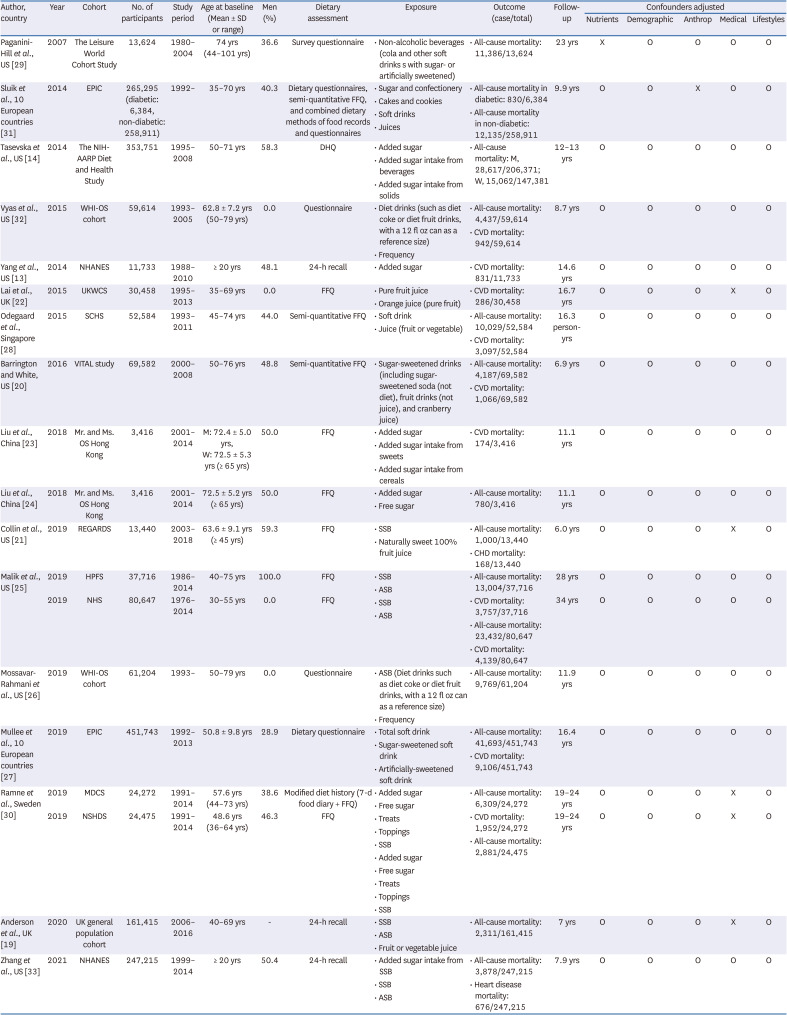
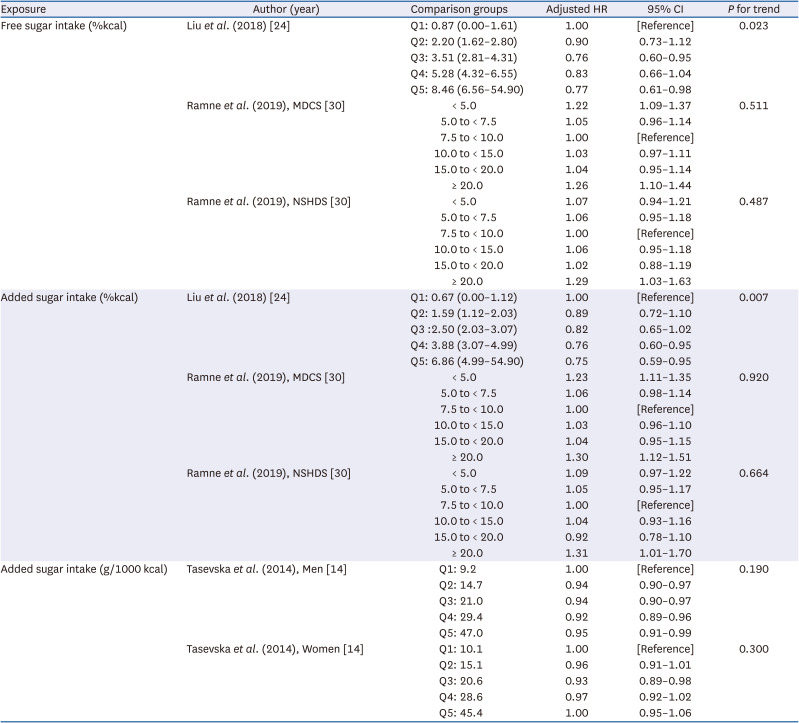
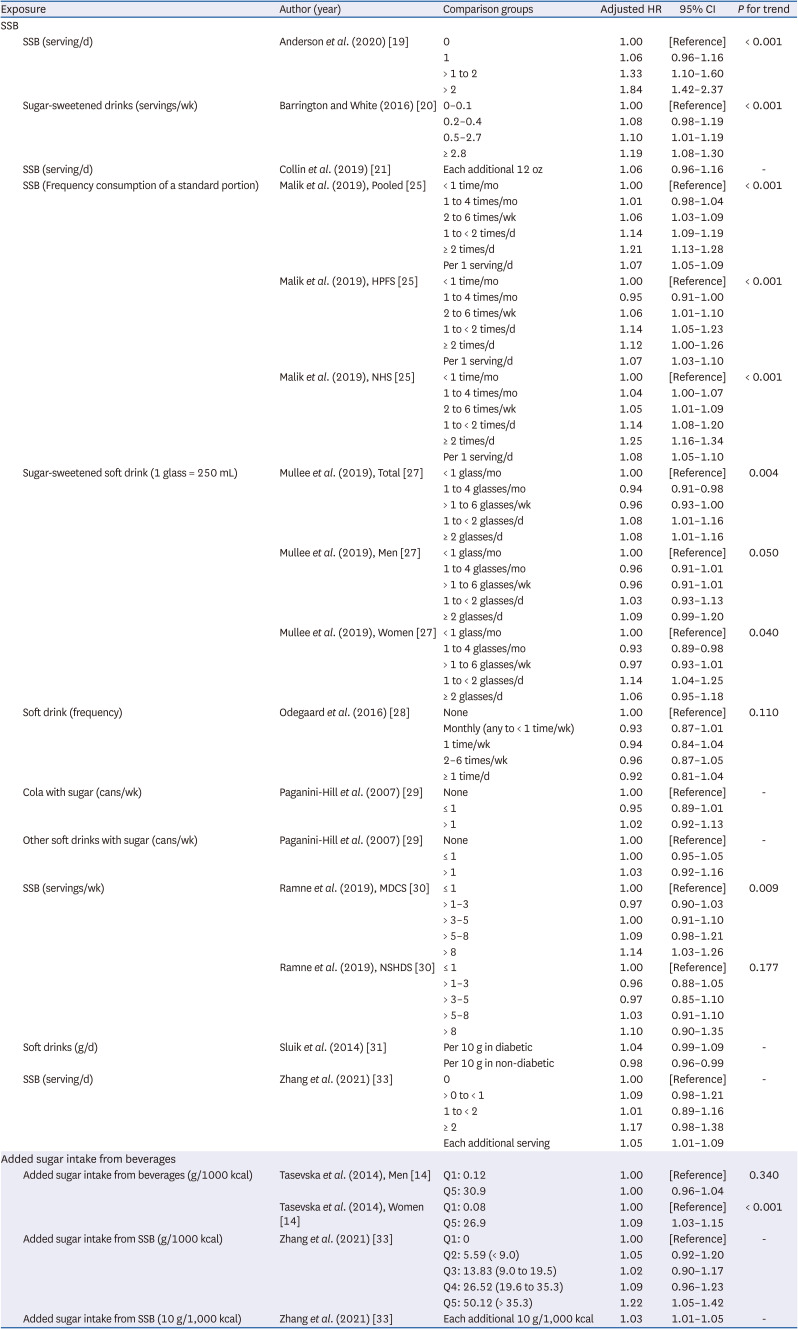
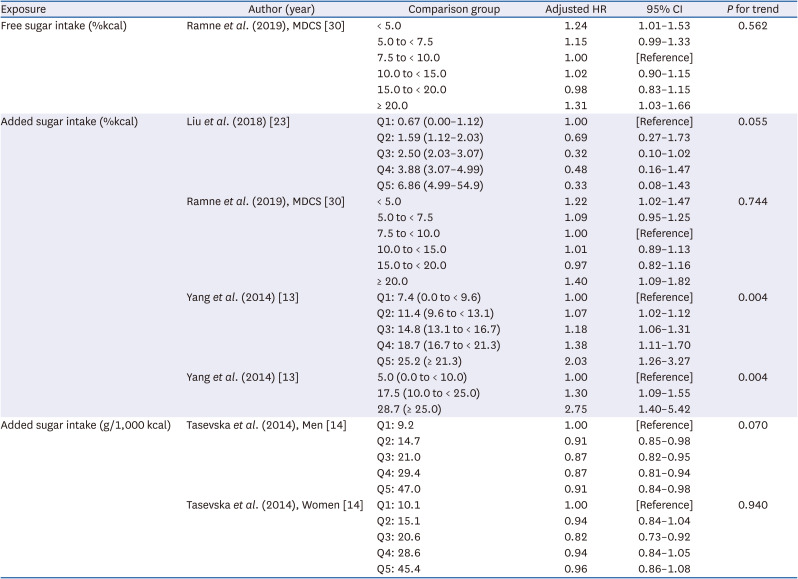
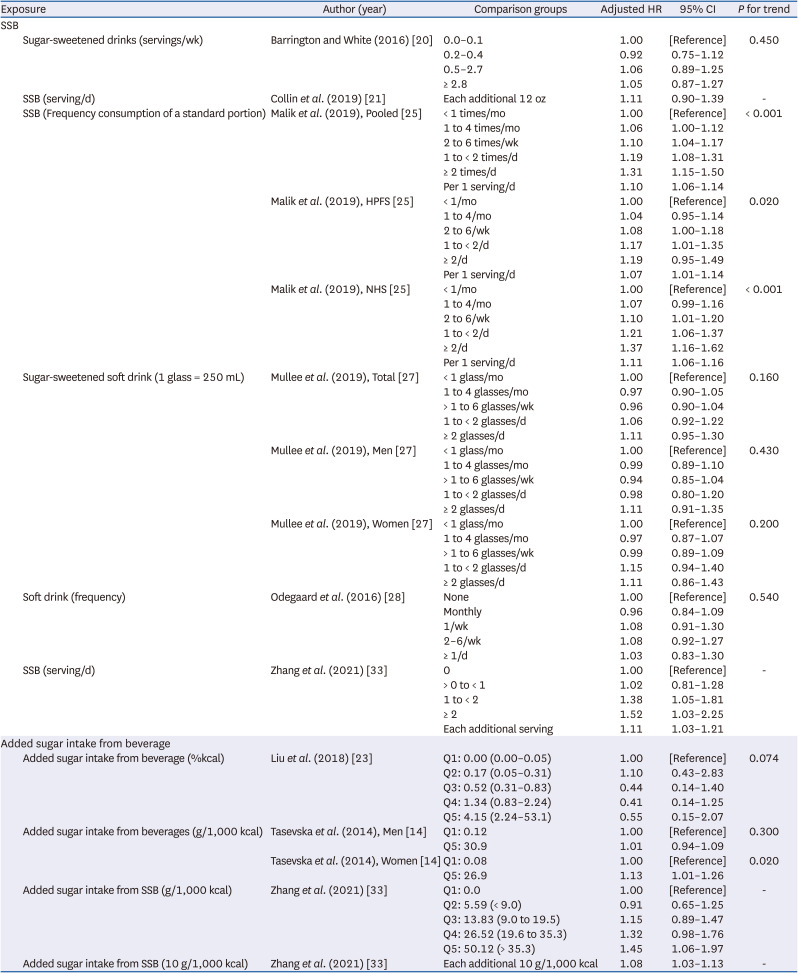




 PDF
PDF Citation
Citation Print
Print



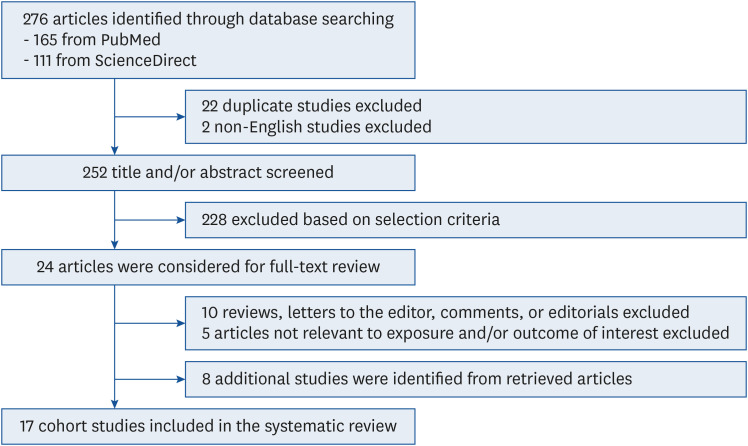
 XML Download
XML Download